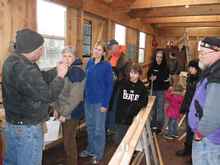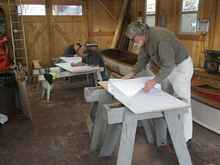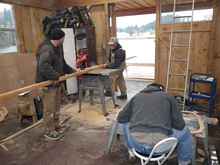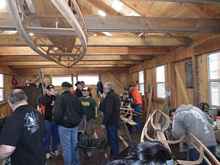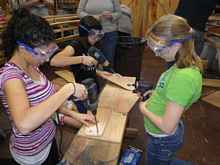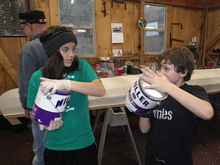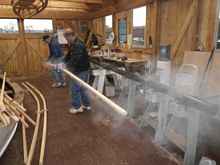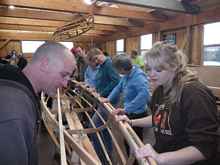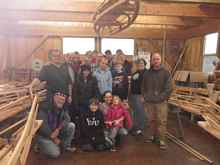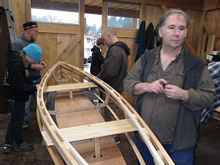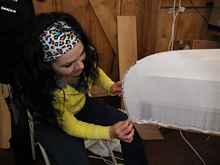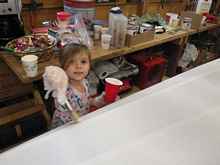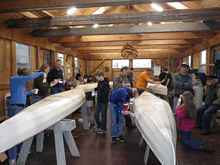Toledo Community Boathouse Christmas Boat Build
Toledo, Oregon, is a tiny timber town about 11 mils upriver from the mouth of the Yaquina River. Timber died in the late 80s and rather than fade into obscurity, the town leaders are fighting tooth and nail to keep this itty-bitty burg relevant in the 21st century. One of the efforts is the Toledo Community Boathouse.
Staffed by volunteers, the Boathouse itself is a 40x20 floating shack moored at the docks along Depot Slough. Through tireless efforts of the volunteers and generous grants, the Boathouse has become a full-on workshop with all the tools needed to build, repair and maintain small, wooden boats.
The Toledo Community Boathouse exists to provide opportunities for visitors and residents to engage in on-the-water and waterfront activities. This mission is easy enough to fulfill during the summer months, but the Oregon winters are long, cold, and wet. Finding something to keep the Boathouse in the public eye during the long, dank, nights is a unique challenge.
The volunteers met and discussed possibilities. It was decided to host a Family Boat Build - four families building four boats during the school district's Winter Break - the five days between Christmas and New Years. The design parameters grew as much out of the audience and time constraints as anything else. It was a family project, so the boats had to be able to carry at least two people. Because of space constraints, the boats couldn't be much over 16 feet long. It was decided sailboats require too many 'fiddy bits.' Because the focus was on families, building couldn't require too much power tool usage and exposure to toxic glues needed to be minimized or eliminated.
Above all, the boats had to be cheap, easy to build, and look fantastic. After some experimentation, it was decided to go with a Skin-on-Frame design, specifically Dave Gentry's 15 foot Rushton IGO.
Skin-on-Frame turned out to be ideal: While the word went out to the local media, calling for teams of at least four people (one enrolled in middle or high school) to apply, the Boathouse volunteers cut all the pieces and purchased the materials. The slough was ringing with the sound of industry in the weeks leading up to the event and wood chips were flying.
On December 26, the doors slid open and welcomed three families - one family was down with the flu, but as luck would happen, a couple had heard about the project through the grapevine and came down "to check things out." They were given tools and put to work on the fourth boat.
The workdays were short - 11am to 1pm, this was Christmas Break, after all. It took two days to go from piles of sticks to the assembly of the skeleton. The stringers were lashed to the frames using artificial sinew, so the teams learned how to tie Eskimo knots very well. Once the skeleton was done, it took another day to get the floorboards lashed into place and the seats installed. The fourth family had recovered from the flu just as the looky-loos had to pack up and return home - the building of the fourth canoe continued without interruption.
The teams had kids as young as 5 and as old as 72. At one point, there were 32 people in the Boathouse. Average attendance was 22 participants, including the three Boathouse volunteers.
While the wind and rain howled outside, the canoes slowly took shape.
Something magical was happening: As the day came to a close, some teams were further along than others. Without command, the teams would shift and reform, some people moving to the boats that were behind in their progress. The help was accepted with welcoming smiles and when it was time, everyone would shift to the next boat.
The fourth day was dedicated to skinning the boats. The 8-ounce polyester cloth was pulled tight and electric staplers were used to hold it in place with stainless steel staples. The final act of the day was to give the boats a coat of water-based, exterior paint.
The final day was a celebration. Rubrails were attached to hide the staples and the boats were given another coat of paint.
In five, three-hour days, four groups of people who had never built anything before - much less built anything together - walked out the door with beautiful Rushton IGO canoes. The only power tools used were drills and saber saws, and no one touched a tape measure the entire time.
The Toledo Community Boathouse is staffed completely by volunteers and survives on donations, gifts, and grants like the one that paid for the materials used in the Family Boat Build. Donations are tax deductible and can be made to:
Toledo Community Foundation ATTN: Toledo Community Boathouse PO Box 2000 Newport, OR 97365.
Here's some pics:
|
The participants are instructed in the fine art of the Eskimo Knot - the knot used to lash the stringers to the frames. |
|
Boathouse volunteers prepare for the Family Boat Build by tracing the patterns for the stems and frames onto plywood. |
|
Boathouse volunteers prepare for the Family Boat Build by ripping stringers and keels from lengths of fir. |
|
Four 15-foot boats and 32 people have the Boathouse nearly at capacity. |
|
One of the participants, using a Japanese Pull saw for the first time, carefully trims the end off a rubrail. |
|
Three young women, 14 years old, learn how to use drills and countersinks. |
|
A 13-year-old and her 10-year-old brother learn shaking is an effective method of making sure paint is properly mixed. |
|
Boathouse volunteers prepare for the Family Boat Build by steaming and bending the wales. |
|
Teams shift and morph, people going to where they are needed to help keep the project moving. |
|
Four teams made up of families and friends came together to build some skin-on-frame canoes at an event hosted by the Toledo Community Boathouse. |
|
The frames, stringers, wales, floorboards, and seats are all in place and the boat is ready for skinning. |
|
The Skin-on-Frame building technique requires learning a a wide range of skills, including sewing and using the Running Stitch and Whip Stitch to seal off the stems. |
|
The only thing more fun than building a boat is painting a boat. |
|
One of the beauties of the Skin-on-Frame technique is neophytes can be included in all phases of construction. |
|



